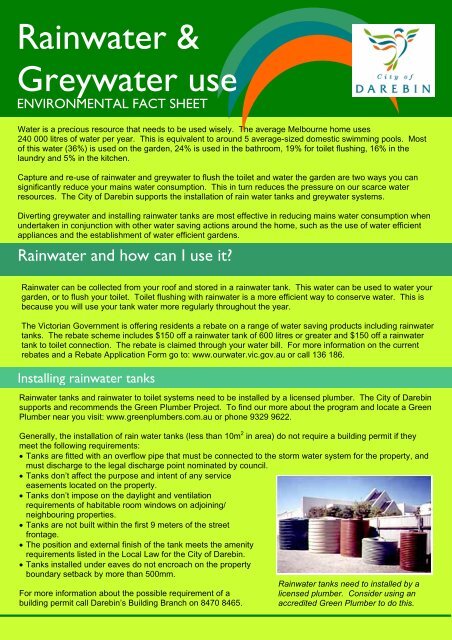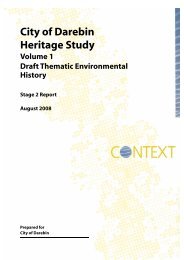Rainwater & Greywater use - City of Darebin
Rainwater & Greywater use - City of Darebin
Rainwater & Greywater use - City of Darebin
- No tags were found...
Create successful ePaper yourself
Turn your PDF publications into a flip-book with our unique Google optimized e-Paper software.
<strong>Rainwater</strong> &<strong>Greywater</strong> <strong>use</strong>ENVIRONMENTAL FACT SHEETWater is a precious resource that needs to be <strong>use</strong>d wisely. The average Melbourne home <strong>use</strong>s240 000 litres <strong>of</strong> water per year. This is equivalent to around 5 average-sized domestic swimming pools. Most<strong>of</strong> this water (36%) is <strong>use</strong>d on the garden, 24% is <strong>use</strong>d in the bathroom, 19% for toilet flushing, 16% in thelaundry and 5% in the kitchen.Capture and re-<strong>use</strong> <strong>of</strong> rainwater and greywater to flush the toilet and water the garden are two ways you cansignificantly reduce your mains water consumption. This in turn reduces the pressure on our scarce waterresources. The <strong>City</strong> <strong>of</strong> <strong>Darebin</strong> supports the installation <strong>of</strong> rain water tanks and greywater systems.Diverting greywater and installing rainwater tanks are most effective in reducing mains water consumption whenundertaken in conjunction with other water saving actions around the home, such as the <strong>use</strong> <strong>of</strong> water efficientappliances and the establishment <strong>of</strong> water efficient gardens.<strong>Rainwater</strong> and how can I <strong>use</strong> it?<strong>Rainwater</strong> can be collected from your ro<strong>of</strong> and stored in a rainwater tank. This water can be <strong>use</strong>d to water yourgarden, or to flush your toilet. Toilet flushing with rainwater is a more efficient way to conserve water. This isbeca<strong>use</strong> you will <strong>use</strong> your tank water more regularly throughout the year.The Victorian Government is <strong>of</strong>fering residents a rebate on a range <strong>of</strong> water saving products including rainwatertanks. The rebate scheme includes $150 <strong>of</strong>f a rainwater tank <strong>of</strong> 600 litres or greater and $150 <strong>of</strong>f a rainwatertank to toilet connection. The rebate is claimed through your water bill. For more information on the currentrebates and a Rebate Application Form go to: HTwww.ourwater.vic.gov.auTH or call 136 186.Installing rainwater tanks<strong>Rainwater</strong> tanks and rainwater to toilet systems need to be installed by a licensed plumber. The <strong>City</strong> <strong>of</strong> <strong>Darebin</strong>supports and recommends the Green Plumber Project. To find our more about the program and locate a GreenPlumber near you visit: HTwww.greenplumbers.com.auTH or phone 9329 9622.2Generally, the installation <strong>of</strong> rain water tanks (less than 10mPPin area) do not require a building permit if theymeet the following requirements:• Tanks are fitted with an overflow pipe that must be connected to the storm water system for the property, andmust discharge to the legal discharge point nominated by council.• Tanks don’t affect the purpose and intent <strong>of</strong> any serviceeasements located on the property.• Tanks don’t impose on the daylight and ventilationrequirements <strong>of</strong> habitable room windows on adjoining/neighbouring properties.• Tanks are not built within the first 9 meters <strong>of</strong> the streetfrontage.• The position and external finish <strong>of</strong> the tank meets the amenityrequirements listed in the Local Law for the <strong>City</strong> <strong>of</strong> <strong>Darebin</strong>.• Tanks installed under eaves do not encroach on the propertyboundary setback by more than 500mm.For more information about the possible requirement <strong>of</strong> abuilding permit call <strong>Darebin</strong>’s Building Branch on 8470 8465.<strong>Rainwater</strong> tanks need to installed by alicensed plumber. Consider using anaccredited Green Plumber to do this.
What is greywater and how can I <strong>use</strong> it?<strong>Greywater</strong> is all non-toilet (blackwater) ho<strong>use</strong>hold waste water, including laundry and bathroom water.<strong>Greywater</strong> sourced from your bathroom and laundry can be diverted and <strong>use</strong>d to water your garden and/orflush your toilet in an untreated form.You can <strong>use</strong> greywater by:• Letting your washing machine or shower water run into a bucket which you empty onto the garden.• Installing a temporary or permanent greywater diverter (to divert water onto your garden) which you canpurchase from hardware and plumbing supply stores.• Installing a temporary storage and toilet flushing system, such as the Wattworks system.• Installing an EPA approved greywater storage and treatment system.If you want to install a permanent greywater diverter or storage and treatment system you will need to <strong>use</strong> alicensed plumber.Important facts to remember about greywater• Ensure that any greywater <strong>use</strong>d does not leave your property and does not run into the stormwater system.• Ensure you <strong>use</strong> laundry detergents that are low in salt, phosphorous and nitrogen. Generally liquiddetergents have lower phosphorous and sodium levels, as compared to powders (for more information go towww.lanfaxlabs.com.au).• Only divert laundry or bathroom water, not kitchen water as it is heavily contaminated with fats, greases andsolids.• Don’t divert greywater that has faecal contamination, such as nappy wash water.• Avoid watering vegetables that will be eaten raw.• Don’t store greywater for more than 24 hours.• Don’t allow children or pets to drink or play with greywater.Other water saving ideasThere are many other things you can do in and around your home to save water, some <strong>of</strong> these include:• Install and <strong>use</strong> AAA (water efficient) taps, showers, appliances and dual flush toilets.• Take shorter showers.• Plant a water efficient garden using native or low water tolerant plants.• Mulch your garden beds and water only in the early morning or evening.• Use hoses fitted with trigger nozzles to ensure you only water what you need to.• Use a plug in the sink when rinsing dirty dishes and washing vegetables.• Only <strong>use</strong> your washing machine and dishwasher when you have full loads.• Wash your car on the lawn using a bucket, to make better <strong>use</strong> <strong>of</strong> the water and reduce pollution entering thecreeks and rivers through the stormwater system.• Sweep paths and driveways around the ho<strong>use</strong> using a brush, rather than a hose.• Don’t leave the tap running while you brush your teeth or while you shave.For more information from <strong>Darebin</strong> <strong>City</strong> Council go to:HTwww.darebin.vic.gov.auTH/environment, email mailbox@darebin.vic.gov.au or call (03) 8470 8888For more information on what you can do to save water at home and <strong>use</strong> <strong>of</strong> rainwater andgreywater go to:HTwww.epa.vic.gov.auTH – Victorian Environment Protection Authority websiteHTwww.sgaonline.org.auTH – Sustainable Gardening Australia’s websiteHTwww.ourwater.vic.gov.auTH – Department <strong>of</strong> Sustainability and Environment’s websiteHTwww.savewater.com.auTH – For excellent water saving ideasHTwww.greenplumbers.com.auTH – Green Plumbers Project websiteHTwww.melbournewater.comTH – Melbourne Water’s websiteHTwww.yvw.comTH – Yarra Valley Water’s websiteHTwww.environment.vic.gov.auTH - Gateway site to many other environment sites

















